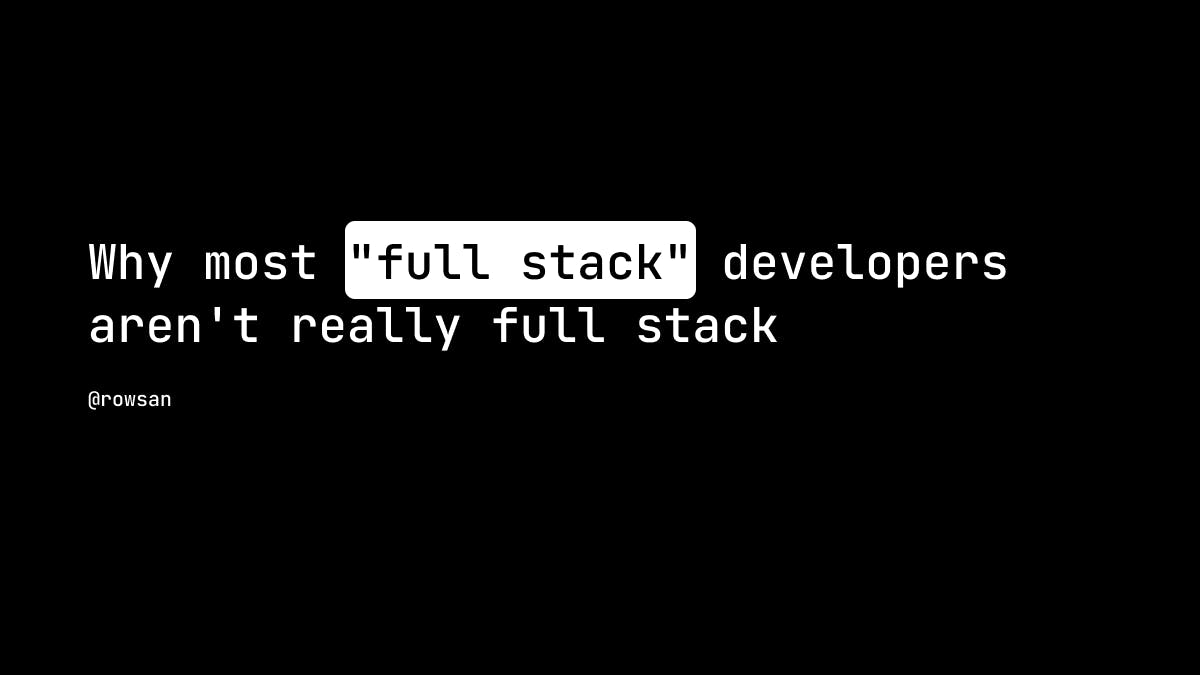Why Most "Full Stack" Developers Aren’t Really Full Stack
Most developers call themselves "full stack."
But if you ask them to build a feature across the entire stack—
From setting up the database
To building the backend logic
To designing and deploying a frontend UI
To pushing the project live…
They freeze.
Because being “full stack” isn’t about knowing the buzzwords.
It’s about solving problems end-to-end.
Let’s break down why the term “full stack developer” is so misunderstood—and what it really takes to become one.
The Stack Isn’t Just Code
Here’s the truth:
Being a full stack developer doesn’t mean you’ve written a few Node.js APIs and built a React frontend.
That’s just surface-level.
Real full stack means you can:
→ Design and normalize a database schema
→ Write secure and scalable backend logic
→ Build a clean, responsive, and accessible frontend
→ Handle authentication and authorization
→ Write tests (yes, that too)
→ Set up CI/CD and understand deployments
→ Debug issues across layers
→ Understand how all the parts talk to each other
And that’s just for one small feature.
The Resume Title Trap
The industry loves labels.
People love to write “full stack developer” on their LinkedIn because it sounds powerful.
It sounds like you can do it all.
But the truth?
Most of them haven’t even deployed an app by themselves.
They haven’t written a Dockerfile.
They haven’t dealt with production logs, 500 errors, or memory leaks.
They’ve built a to-do app and maybe used Firebase once.
That’s not full stack.
That’s frontend with some database glue.
Why It Happens
Let’s be honest.
The learning curve is steep.
The stack is too wide for most people to go deep.
Bootcamps teach you the basics, but they don’t teach you:
→ Infrastructure
→ Web security
→ Caching strategies
→ Load balancing
→ Rollbacks and failure recovery
They skip the hard parts.
Because teaching "MERN stack" is easier than teaching how the web actually works.
And so, people walk out of bootcamps thinking they’re full stack…
When in reality, they’re still frontend-first.
The Confidence Illusion
Let’s say you can build a simple app top to bottom.
Does that make you full stack?
It depends.
Because building an app that runs on your laptop is not the same as building something production-ready.
There’s a gap between can make it work and can make it last.
Production introduces complexity:
→ Performance issues
→ Race conditions
→ Data consistency
→ Downtime recovery
→ Security patches
Knowing the tools is one thing.
Knowing when, why, and how to use them is what makes you full stack.
The Real Full Stack Mindset
It’s not about being perfect at everything.
You don’t need to master DevOps, backend, frontend, and database engineering all at once.
But you need ownership.
You need to be the kind of developer who says:
“I’ll figure it out.”
“I can trace this bug across layers.”
“I know how to build something end-to-end.”
Because full stack is not a title.
It’s a mindset of problem-solving across boundaries.
What They Don’t Teach You
Here are things most so-called full stack devs avoid:
→ How to scale APIs under heavy load
→ What CORS really is and how to fix it
→ How to avoid SQL injection
→ Setting up domains and SSL certificates
→ Handling state between frontend and backend properly
→ Writing code that’s easy for other people to work with
They stick to what they know.
Which usually means copying code from Stack Overflow and hoping it works.
That’s not full stack.
That’s surface stack.
You Don’t Need to Know Everything
Let’s be clear:
No one is asking you to become an expert in everything.
But if you call yourself full stack, you should:
→ Be comfortable jumping between layers
→ Know how the data flows from client to database and back
→ Understand how your choices affect performance, security, and UX
→ Be able to build a feature across the stack—not just in one part of it
If you’re afraid of the backend, you’re not full stack.
If you only know how to fetch data but not handle errors, you’re not full stack.
If you can’t deploy your app or debug issues in production, you’re not full stack.
What To Do Instead
Drop the title.
Earn the skill.
Don’t label yourself full stack unless you’ve truly:
→ Built, deployed, and maintained your own projects
→ Worked with a real backend framework
→ Configured hosting and understood what’s going on under the hood
→ Built frontend apps that aren’t just styled, but are actually usable
→ Handled user authentication and sessions properly
→ Learned how to write scalable, maintainable code across both ends
Instead of learning one tutorial and calling it a day—
Go deep.
Build more.
Break things.
Fix them.
That’s how you learn the stack.
It’s Not About the Stack
Here’s the kicker:
Being full stack isn’t really about the stack.
It’s about understanding systems.
About solving problems, not just writing code.
The stack is just the tool.
The real job is to create something that works for people.
And that means knowing:
→ What to build
→ Why it matters
→ How to make it reliable
→ How to fix it when it breaks
The Bottom Line
Most “full stack developers” are just frontend developers who dabble in backend.
But the real ones?
They’re quiet.
They’re not posting “hire me” tweets.
They’re too busy building.
And when they do speak, they say things like:
“I debugged a memory leak at 2 AM.”
“I deployed the fix across three regions.”
“I refactored the code so we don’t repeat this again.”
That’s the full stack mindset.
Not a buzzword.
Not a title.
Just someone who gets it—from start to finish.


